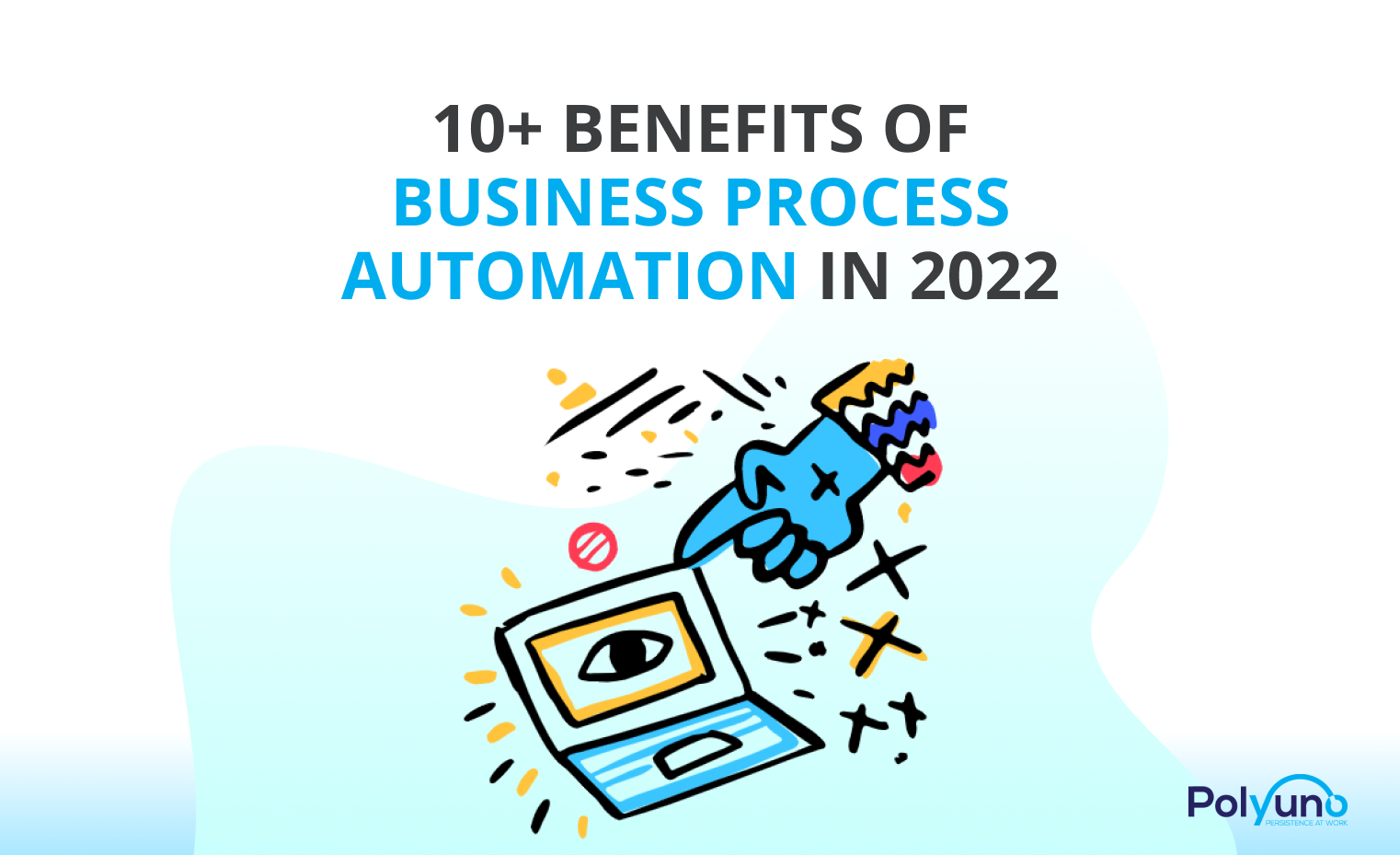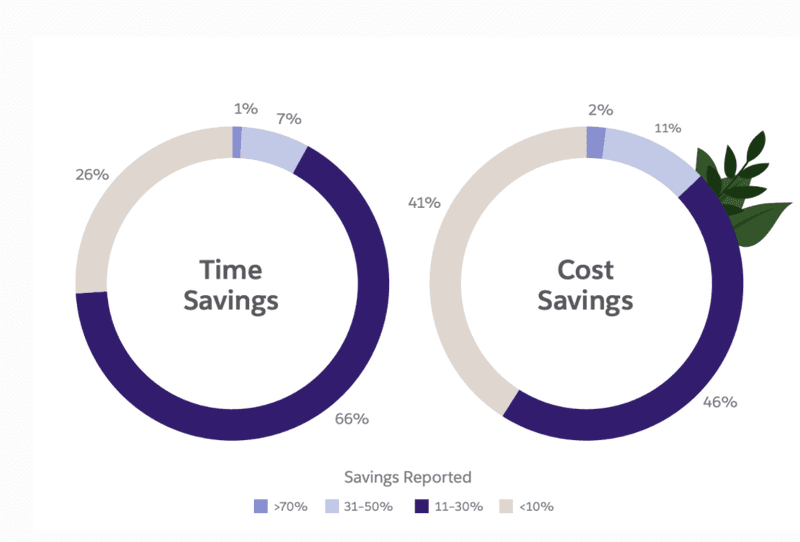
Business process automation has been propelled across sectors and companies due to fast technological advancements. Today, an increasing number of businesses are opting to automate their operations, with the market for business process automation solutions becoming more contemporary and extensive.

By 2022, 59 percent of business processes may be automated, according to one study of Redwood Software and Sapio Research, 2017.
In this article, we’ll guide you through 10+ benefits of Business Process Automation (BPA), along with the importance of using BPA and some basic BPA tools.
Let's start with a quick definition of a business process to better comprehend business process automation. A business process is any series of operations that assists a company in achieving a certain goal. It's generally a repeatable transaction that comprises several stages involving various IT systems.
Fulfilling a client order, accepting a loan application, processing a financial report, and onboarding a new employee are all examples of regular business procedures.
These processes often include several email threads, papers, and handoffs when administered ad hoc. Even a little blunder can kick off a chain reaction of inefficiencies, including failures in communication and missed deadlines.
Business process automation (BPA) is a technology-based method for businesses to simplify their workflows and prevent these problems. BPA allows technologically advanced companies to automate a variety of repetitive activities, reducing their reliance on human involvement.
To organize data and obtain real-time information, businesses are increasingly relying on digital technologies. However, as workloads increase and IT gets more complicated, manually managing project operations will no longer suffice to keep businesses competitive.
BPA helps businesses to move their attention away from manual, time-consuming processes and onto improving, coordinated workflows that may add to company value efficiently and effectively. This entails creating flexible business processes that transcend environments and give real-time data for enterprise-wide visibility and management.
It is safe to say that, Business Process Automation is needed for a holistic, unified approach to minimize complexity and to provide greater visibility, insight, and innovation.
Businesses in a variety of industries are working hard to automate and streamline time-consuming business procedures that are important to their success. It should come as no surprise to many that software is at the core of this.
Macros are the most basic of automation tools. These are straightforward applications that can do complex computations, text replacements, and spreadsheet shortcuts. They come in handy when it comes to data input and database updates.
RPA (Robotic Process Automation) bots are another game-changing technology that has changed the way people execute monotonous jobs. They feature intuitive drag-and-drop interfaces that make it easier for the employees to leverage the potential of automation to speed up and eliminate errors in daily activities.

Cognitive or intelligent bots are RPA bots that have been enhanced with AI (Artificial Intelligence), NLP (Natural Language Processing), or image recognition (OCR) skills and may be used for more complicated automation.
Low-code or no-code application platforms, which enable non-technical personnel to automate processes quickly, are another type of software used in process automation.
Companies are now using more complicated and specialized business process automation tools to automate complex, multi-system operations.
One of the main benefits of automation is that it frees up your human talent to do what they do best: plan intelligently, sell effectively, and create brilliantly. According to an MIT Sloan survey, 91 percent of CEOs believe digital technologies have the capacity to profoundly change the way businesses operate.
Automation may boost your company's productivity in a variety of ways. Your program can categorize files as soon as they're received thanks to process automation, freeing up hours for people to conduct the main work.
Employees spend 25% of their time seeking information, according to a survey conducted by the Economist Intelligence Unit.
Allowing automation tools to reach out to possible recruits, arrange interviews, and process employee information may help HR and recruiting staff to be more efficient. Process automation systems may also be used to generate sales leads, issue automatic analytical reports, create briefings, and follow up with customers.
Within 5 minutes, less than 1% of B2B companies call or email an inbound lead. Given that delaying your response time from 5 to 10 minutes reduces your chances of qualifying a lead by 400 percent, it's apparent that businesses are squandering a lot of money.
You can intelligently route leads using automation. This means you're effortlessly exchanging leads with reps and providing them with the information they want from your CRM, which you're sharing with reps on the platform they're currently using.
Unproductive prospecting accounts for 50% of sales time. It doesn't have to be a hit-or-miss situation when it comes to sales.
With the appropriate tools, you can quickly discover high-quality prospects. It all comes down to getting to know your clients, which is crucial to making a sale.
Understanding what your consumers require at each stage of the buyer's journey is critical to developing connections with them. The appropriate tools that support your goals throughout the sales cycle make mapping lead nurturing content easy peasy.
Only 9% of companies have a comprehensive, fully-utilized MarTech stack, even though 51% of companies use 21 or more digital marketing tools.
From content management and CRM to analytics and social media tools, a marketing technology stack is the combined usage of specialized technologies for your marketing activities.
With the rapid growth and adoption of MarTech, it's evident that businesses are realizing the benefits of digital marketing solutions.
There are a lot of apps in the MarTech market, but employing a handful of them does not imply a MarTech stack. The integration connects your marketing tools and helps you to create automated workflows, ensuring that your marketing workflows run smoothly.
BPA automates end-to-end workflows between frequently used back-office applications and cloud-based infrastructures.
This allows help desk teams and business users to easily access real-time data needed to accomplish day-to-day tasks including invoicing, purchase orders, expense reports, approval procedures, customer support, data input, and so on.
The way we look for files has been revolutionized by process automation. All of your data and documents may be uploaded into one central system using automation systems. Gone are the days when employees had to go through six separate systems to find a single document.
Businesses that gather and store data and use it to enhance business processes are known as data-driven companies.

A company may improve the sort of analytics it generates based on the quantity of data it has, but it can also automate certain decision-making processes.
There are occasionally too many decision-makers in the approval process, and sometimes responsible people are just overburdened. Decision-making is postponed in some way or another, and the best way to avoid this is to automate well-structured decisions.
Machine learning techniques may remind decision-makers what their typical solutions were in the past for that precise circumstance when the innovation project has to be pushed further into development.
To make data-driven decisions the norm in your business means to create an environment where everyone collaborates and ensures transparency taking insights from data analytics. A free flow of data inside the company allows everyone to make informed decisions.
Employee happiness may help a company succeed. Happy employees are up to 20% more productive than dissatisfied employees.
64 percent of corporate business experts expect to create automation aimed at boosting employee experience in the next two years.
The objective of automation is not to have computers take overall employment. Rather, the aim is to allow your employees more time to focus on work that makes a genuine impact while still ensuring that the mundane, day-to-day tasks are completed.
A lack of alignment within a team, according to 97 percent of employees and executives, influences the outcome of a job or project.
Teams and departments in any successful organization run like well-oiled machines. Collaboration is essential for effective operation, and this necessitates keeping up with the efforts of all departments.
From syncing departmental apps to automating extensive processes like onboarding and reporting, automation successfully supports overall operations by making it easier to get everyone on the same page.
Bots that automate processes may reply to customers at any time of day. They are not only always active, but they can also reply to many clients at the same time.
In addition to email, instant chat, and text, the automated tool may reply to queries on a variety of platforms. Quick responses are essential in a world that prioritizes rapid satisfaction. It also communicates to customers that you respect their time.
57 percent of corporate business experts intend to create automation aimed at improving the customer experience. Personalization is another important aspect of today's consumer happiness.
According to a 2021 study, 71% of Gen Z'ers want highly customized experiences. According to the same survey, 46% of Generation Z wants businesses to remember their buying habits.
Fortunately, keeping track of client preferences and providing a tailored experience is simple. Many intelligent automation solutions can segment and monitor your audience, delivering customized experiences.
CRM and marketing automation (MA) allow you to keep track of your customers' preferences, send personalized emails, and connect with them on a more personal level. Without an automated platform, this type of targeted marketing approach would be difficult to implement. It's also a lot less expensive than paying stalkers.
Important metrics can be captured and reported on to give you the key information you need, depending on whatever process you've chosen to automate (finance, billing, collections, sales, and/or support).

Automation enhances the visibility of operations through customizable dashboards. Multiple processes may be tracked at a glance using established key performance indicators (KPIs). In-depth assessments on process performance reveal areas that need to be improved and keep the team on track.
In everyday work, the appropriate collaboration between man and technology provides for higher revenue. It also enables the reduction of unnecessary expenditures because it is simple to optimize employee work.
Appropriate process automation enables the full use of technology to optimize both the service delivered and the company's costs.
Technical leadership has set its eyes on process automation while people across the company are expected to accomplish more with less. Let’s see how business process automation is used for optimization.

When it comes to business process automation, there are several tools and platforms to select from. It's critical to choose the tasks you wish to automate. It doesn’t have to be the most complex system available.
BPA is a smart investment for businesses that need to automate whole workflows and quickly find solutions.
Looking for a service to create quality digital solutions for your business? Book a call with PolyUno today!